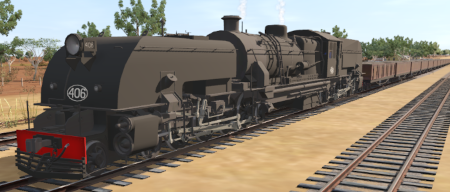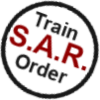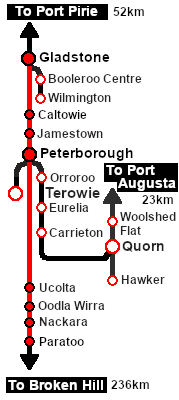From TrainzOnline
(Difference between revisions)
|
|
| Line 8: |
Line 8: |
| | </tr> | | </tr> |
| | <tr valign="top"> | | <tr valign="top"> |
| − | <td align="center" colspan=3>A scenario in the '''[[SAR Peterborough Base Session|SAR Peterborough Base Session v2.0]]'''<br> | + | <td align="center" colspan=3>A scenario in the '''[[SAR Peterborough Base Session V2|SAR Peterborough Base Session v2.0]]'''<br> |
| | <span style="font-weight: 700;"><span style="background-color: yellow;">This scenario has been updated in <span style="color: blue;">Base Session v2.0</span></span>. For the original <span style="color: blue;">v1.0</span> scenario, click <span style="background-color: yellow;">[[SAR Scenario Gladstone Bulk Ore V1|here]]</span></span></td> | | <span style="font-weight: 700;"><span style="background-color: yellow;">This scenario has been updated in <span style="color: blue;">Base Session v2.0</span></span>. For the original <span style="color: blue;">v1.0</span> scenario, click <span style="background-color: yellow;">[[SAR Scenario Gladstone Bulk Ore V1|here]]</span></span></td> |
| | </tr> | | </tr> |
Revision as of 20:25, 11 May 2024
| Express bulk ore from Broken Hill to Port Pirie. Choice between a morning service and a night service. |
 |
The Historical Bit
| The line from Port Pirie to Cockburn on the South Australia - New South Wales border was built in stages from 1875 to 1888. In 1883 lead, zinc and silver ores were discovered at Broken Hill just over the border in New South Wales. This accelerated the development of the line to the border to capture the ore traffic. Because the SAR was not allowed to operate into New South Wales a private railway, the Silverton Tramway, was created to carry the ore across the border. The SAR and Silverton Tramway simply swapped locos at the border. It was called a "tramway" to get around a NSW law banning private railways but not private tramways. Despite the title it was a fully operating heavy haul narrow gauge railway, and it became one of the most profitable railways in the country.
The SAR and Silverton had a monopoly on the ore traffic until 1919 when the NSWGR (New South Wales Government Railways) completed its own standard gauge (4ft 8½in) line from Sydney to Broken Hill but the SAR continued to carry the bulk of the ore because the port and smelter at Port Pirie was much closer to Broken Hill.
A variety of motive power was used on the ore trains. SAR Y class locos were originally used then the SAR T class took over until they were largely replaced by the SAR 406 class in the 1950s. In the 1960s the SAR 830 class (narrow gauge bogies) diesel locos started appearing. The SAR 830 class (standard gauge bogies) continued to haul the ore trains well into the 2000s.
By 1970 the narrow gauge line from Port Pirie to Broken Hill had been converted to standard gauge and the Silverton Tramway ceased its ore hauling operations but continues to operate today providing standard gauge shunting services and loco leasing to other rail operators. |
 |
| Era: |
1950s and 1960s |
| Duration: |
Peterborough: 1 hour 25 minutes (includes refuelling time)
Gladstone: 2 hours 45 minutes |
| Loco: |
SAR 406 (Garrett) on the Main line approaching Paratoo from the East |
| and at the Peterborough Loco Depot for an optional loco swap |
|
|
|
|
|
|
|
|
|
|
|
| Consist: |
Attached to SAR 406
|
|
|
 |
Each location in the layout has a detailed set of track diagrams that provide a variety of useful information
The Getting Started guide below gives a summary of what is available.
To display this information click any  graphic, or go to the bottom of the page for all the session links (all links will open in this window). graphic, or go to the bottom of the page for all the session links (all links will open in this window). |
Getting Started:
- If you have already closed the opening message window then the first step is to pause the session by pressing the P key.
- If you decide to set the session clock to a different starting time (for example: to match the train timetable shown below) then follow the instructions shown in the Orders section
- Next locate your loco. Either:-
- Open the Finder Tool (press Ctrl F ) and type, in the Name field, the name of the loco, in this case SAR 406 (or just 406 should be enough). Click the tick icon, OR
- Open the Driver List (bottom left of the screen) and then scroll through the list to find either:-
- the loco name (SAR 406) OR
- the driver icon (named Driver 406) - this is a non-animated icon
- then click the drivers Eye icon
 to take control of the loco to take control of the loco
- Take a few moments to get your bearings. Click
 (this link will open in this window) to show the location details and track plans for Paratoo. In each location details page:- (this link will open in this window) to show the location details and track plans for Paratoo. In each location details page:-
- the
 tab gives an overall summary of each location with a "potted" history (where available). tab gives an overall summary of each location with a "potted" history (where available).
- the
 tab reveals the invisible tab reveals the invisible  Track Marks for Drive To commands. Track Marks for Drive To commands.
- the
 tab lists all active industries and their commodities. tab lists all active industries and their commodities.
- the
 tab describes the names, locations and settings of all junction switches as well as some switch sets you may want to use. tab describes the names, locations and settings of all junction switches as well as some switch sets you may want to use.
- Each location details page has direct links to the adjacent locations so you can explore along the route.
- When you are ready to start, reload the Peterborough Base Session page (click the Scenarios button on your current location page) and select this Scenario again or just use the Back button on your browser - whichever is quicker.
- Switch back to Trainz Driver Mode
- Close the opening message window and, if Pause is shown on the screen, press the P key to start the session.
|
|
Tutorial:
 |
A tutorial on using these scenarios is provided in the link on the left. The link will open in this window |
|
Orders:
- Move the train into Paratoo Yard on the Main Line
- Fill the tender with water at the Paratoo Water Column or proceed to Nackara and fill with water at the Water Column located there.
- Proceed to Peterborough Loop or Peterborough Yard 1 .
- Detach the loco and proceed to Peterborough Main Loco Fuel & Water Point to refuel the tender with bunker c oil and water.
- Option: Reattach the loco, or another available loco, to the train and proceed according to the timetable to Gladstone Yard . If you are replacing the 400 class with a different type of loco at Peterborough then you are advised to double-head.
|
 |
| Paratoo-Gladstone Bulk Ore Timetable |
| |
Days
Train № |
|
|
M to Sa
821 |
Su to F
822 |
|
|
|
|
| Paratoo |
ΔCFWX |
arr |
09:35w‡ |
20:30w‡ |
|
| |
dep |
09:40 |
20:40 |
|
| Methuen Loop |
X |
|
09:44 |
20:44 |
|
| Nackara |
WX |
arr |
09:52w |
20:52w2 |
|
|
|
| dep |
09:55 |
20:55 |
|
| Peechara Loop |
X |
|
10:03 |
21:03 |
|
| Oodla Wirra |
WX |
arr |
10:171 |
21:17 |
|
| Ucolta |
WX |
arr |
10:28 |
21:28 |
|
| Peterborough Yard |
CEFJØWX |
arr |
10:43w3 |
21:43w |
Swap/Refuel loco if required |
|
|
| |
dep |
11:05 |
22:00 |
|
| Yongala |
FWX |
arr |
11:16 |
22:12 |
|
| Belalie North |
X |
arr |
11:27 |
22:23 |
|
| Jamestown |
CFØWX |
arr |
11:38 |
22:35w |
|
|
|
| dep |
|
22:40 |
|
| Caltowie |
FX |
arr |
11:49 |
22:51 |
|
| Gladstone Yard |
CEFJØWX |
arr |
12:07w† |
23:10w† |
Refuel loco if required |
|
|
|
| bold time = arrive/depart time |
plain time = timing point |
| Service Symbols: |
| a on request stop |
c coal (if required) |
w water (if required) |
† proceeds to Port Pirie |
| 1 Cross train 101/121/160 |
2 Cross train 721 |
3 Cross trains 261/262/720 |
‡ from Broken Hill |
| † To Port Pirie |
| Location Symbols: |
| Δ = Turning Triangle |
C = Loco Coal Loader |
E = Engine Depot |
F = Fixed Signals |
| J = Junction |
Ø = Loco Turntable |
W = Loco Water Tank |
X = Crossing Loop |
|
|
|
This page was created by Trainz user pware in February 2021 and was last updated as shown below.









